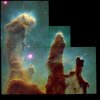I've been having a blast lately processing FITS images from Hubble. What is that you ask? Well, in short, you can download data from the Hubble Space Telescope via the Hubble Legacy Archive, and many other telescopes from around the world on different sites. The images come in a format called FITS, or Flexible Image Transport System. It is the universal language for astronomy data.
I won't go into a super detailed tutorial, unless you guys want me to. There are pretty good instructions on the Hubble site to get you started, as well as some test files. One of the hardest things on my first real image was trying to figure out exaclty what to download. These images don't come as one single image. You must find images from exposures using differnt filters in the red, green and blue ranges. Next, you have to process the FITS images into TIFFS using a program ESA put out called FITS Liberator. Once you have 3 TIFFS, you can merge them in Photoshop to create your RGB image. Then you can tweak the image as much as you need to using levels, curves etc to get the colors to look correct.
This one is my first image from the tutorial data on the Hubble site. It is from an area of the Eagle Nebula named "Pillars of Creation"

This next one is of a galaxy so romantically named "NCG 1300". Despite its name, its pretty awesome. It is considered the prototypical barred spiral galaxy. NCG 1300 is about 63 million light years away from earth. This image was my first "real" image I did. So far, it is only half of the galaxy. Hubble took 2 sets of pictures called "pos1" and "pos2". This image is from "pos2". I plan on downloading the next set, processing and merging both images to get a nice picture of the whole galaxy. Downloading the images takes a long time. Each image from a wavelength is about 500MB. That means the raw data to create this image was 1.5 GB.

If you like Photoshop, this is really a blast. The only thing you need to get started if you have Photoshop or Photoshop Elements is the free FITS Liberator. If you want to do this and have a Mac that is upgraded to El Capitan or above, let me know. You will need a workaround that I figured out. The workaround on their site is not correct for newer installations of OS X.
I won't go into a super detailed tutorial, unless you guys want me to. There are pretty good instructions on the Hubble site to get you started, as well as some test files. One of the hardest things on my first real image was trying to figure out exaclty what to download. These images don't come as one single image. You must find images from exposures using differnt filters in the red, green and blue ranges. Next, you have to process the FITS images into TIFFS using a program ESA put out called FITS Liberator. Once you have 3 TIFFS, you can merge them in Photoshop to create your RGB image. Then you can tweak the image as much as you need to using levels, curves etc to get the colors to look correct.
This one is my first image from the tutorial data on the Hubble site. It is from an area of the Eagle Nebula named "Pillars of Creation"

This next one is of a galaxy so romantically named "NCG 1300". Despite its name, its pretty awesome. It is considered the prototypical barred spiral galaxy. NCG 1300 is about 63 million light years away from earth. This image was my first "real" image I did. So far, it is only half of the galaxy. Hubble took 2 sets of pictures called "pos1" and "pos2". This image is from "pos2". I plan on downloading the next set, processing and merging both images to get a nice picture of the whole galaxy. Downloading the images takes a long time. Each image from a wavelength is about 500MB. That means the raw data to create this image was 1.5 GB.

If you like Photoshop, this is really a blast. The only thing you need to get started if you have Photoshop or Photoshop Elements is the free FITS Liberator. If you want to do this and have a Mac that is upgraded to El Capitan or above, let me know. You will need a workaround that I figured out. The workaround on their site is not correct for newer installations of OS X.







